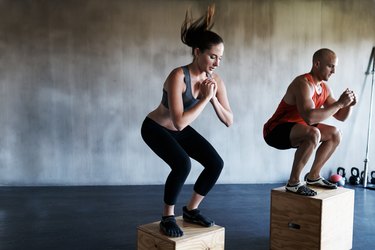
There are several sports that require participants to spend a lot of time airborne. Physical activities such as basketball, volleyball, high jump and gymnastics test your athleticism and ability to propel yourself upward, which is why knowing the jumping muscles used is so critical for success.
Tip
The vertical jump uses the muscles in your lower body, including the quads, hamstrings, glutes and calves. It also recruits the muscles in your core and upper body for power and stabilization.
Video of the Day
What Is a Vertical Jump?
Some people call it a test of athleticism and skill, while others say it can determine how good you will be at certain sports. But the reality is, the vertical jump simply helps determine how high you can elevate yourself off the ground. Because this move requires lower-body strength and explosive power, it's considered a plyometric exercise.
Plyometric training involves a series of explosive body-weight resistance exercises using the stretch-shortening cycle of the muscle fiber to enhance physical capacity such as speed, strength and power, according to the National Strength and Conditioning Association. Most plyometric exercises include jumping, such as the vertical jump, squat jumps, box jumps and plyo lunges.
Including vertical jump training in an overall fitness routine is beneficial to both athletes and recreational gym-goers. Because minimal equipment is needed, you can incorporate the vertical jump into any strength-training workout to increase your heart rate and burn calories between sets or include it in a skill-specific plyometric routine.
What Muscles Do You Use to Jump Vertically?
What muscles make you jump higher? Some of the most important muscles for jumping are the quads, glutes, hamstrings and calf muscles. To get a better idea of how each of these muscle groups contributes to the progression of the vertical jump, you can divide them by the action they perform.
For example, the muscles used to extend the knee are the quadriceps, below.
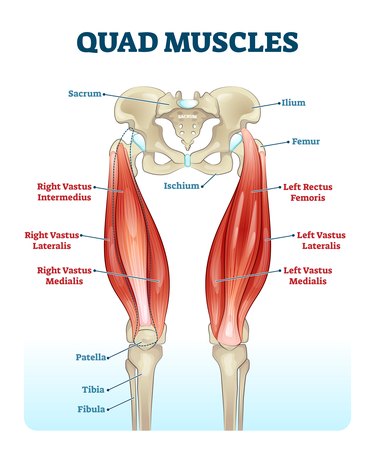
The gluteus maximus and hamstrings, below, are hip extensor muscles that extend the hip when you stand or jump up.
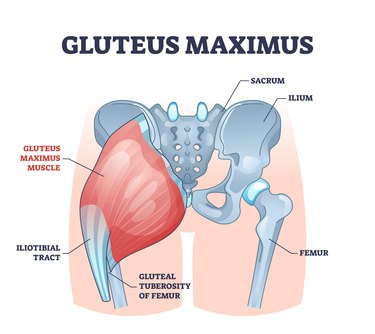
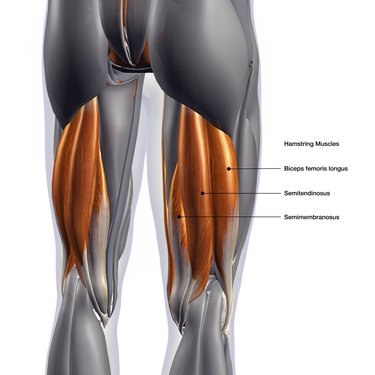
When you point your toes before leaving the ground, you perform a motion known as plantar flexion. This taxes the calf muscles, below, which include the gastrocnemius and soleus.
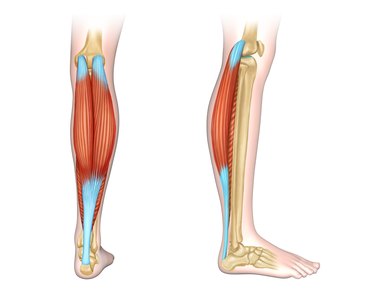
But it's not just the lower-body muscles that do all the work. Other muscles that help you jump higher include the muscles in your upper body. While their contribution is minimal compared to the glutes, hamstrings, quads and calves, the muscles in your shoulders, arms, back and chest do play a role in how high you can go.
Your core muscles will also get a fantastic workout when performing the vertical jump. Power, athleticism and coordination are required to perform this move correctly; you'll need to rely on your core muscles to generate explosive power to propel you upward while maintaining proper form.
Types of Vertical Jumps
There are three different types of vertical jumps you can do, according to a September 2021 study in the International Journal of Strength and Conditioning, which looked at the multiple types of vertical jumps that happen in basketball and the strength used to do them. They are:
- Standing vertical jump: Jumping as high as you can with no steps used prior to takeoff, using two legs.
- Running vertical jump with a double-leg takeoff: Jumping as high as you can with two or more steps used prior to takeoff, using two legs.
- Running vertical jump with single-leg takeoff: Jumping as high as you can with two or more steps used prior to takeoff, using one leg.
How to Increase Your Vertical Jump
In order to improve your vertical jump, you need to train this specific movement on a regular basis.
Luckily, there are a few plyometric and strength drills you can do that are especially helpful in maximizing your jumping height, because they work the muscles used when you jump.
1. Seated Box Jump
- Begin seated on a short box or step with your knees bent and feet flat on the floor. Have a sturdy, taller box or step in front of you, but make sure there’s a little space in between the two platforms for you to jump over.
- Stand up and, without pausing, explode upward. Use your arms to help you propel yourself and jump both feet onto the taller box or step.
- Land softly on the taller box with your knees bent.
- Step back down.
- Do 3 to 4 sets of 6 to 8 reps.
2. Depth Jump
- Begin standing on a short box or step. Have a sturdy, taller box or step in front of you, but make sure there’s plenty of space in between the two platforms.
- Step off the short box or step so you’re directly in front of the taller box or step.
- The moment your feet make contact with the ground, explode upward. Use your arms to help you propel yourself and jump both feet onto the taller box or step.
- Land softly on the taller box with your knees bent.
- Step back down.
- Do 3 to 4 sets of 6 to 8 reps.
3. Barbell Back Squat
- Duck under the bar and position yourself so that it rests high on the back of your shoulders. Make sure the bar rests on the meaty party of your shoulders, not on your neck, and grasp it on either side for stability.
- Stand up beneath the bar to take its weight on your legs. Step back into the squat rack/squat cage so the bar will clear the racking pins, and set your feet shoulder-width apart. Adjust your position, if necessary, so you're stable and balanced.
- Bend your knees as you move your hips back and down as if you were sitting in a chair behind you. Your torso will tilt forward from your hips, but keep your back straight.
- Lower until your thighs are parallel with the ground (or as low as you can comfortably squat while maintaining good form).
- Press through your feet to reverse the motion and return to standing.
- Do 3 to 4 sets of 6 to 8 reps.
4. Barbell Deadlift
- Fix the weight plates on your barbell and position it on the floor in front of you. If needed, position it on an elevated platform to allow for a reduced range of motion.
- Step up to the bar, shins almost against it, feet planted firmly hip-width apart. Keep your spine straight, chest up and shoulders back and down.
- Hinge from the hips, softening your knees as your hips sink low enough so you can grasp the bar with your hands shoulder-width apart.
- Check your posture: Your spine should be straight and long, chest up and open and shoulders back.
- Engage all the muscles of your core to maintain this position as you push your feet into the floor. Imagine that you are trying to push the floor away from you, and stand up.
- Finish the motion by lifting your chest and engaging your lats to stabilize the bar in front of your hips.
- Return the bar by reversing the motion, pushing your weight back into your hips and softening your knees, letting the bar travel in a controlled path back down to the floor along your body.
- Do 3 to 4 sets of 6 to 8 reps.
5. Barbell Hip Thrust
- Sit on the ground with the bottom of your shoulder blades on the edge of an exercise bench or box.
- Extend your legs out in front of you and roll a barbell up over your hips, placing a cushion underneath the bar for comfort if needed.
- Bend your knees and place your feet flat on the ground.
- Keeping your neck long, press into your heels and raise your hips off the ground, lifting the barbell up. As you bridge up, your neck and shoulders should move onto the bench.
- Pause here for a moment, then lower back down.
- Do 3 to 4 sets of 6 to 8 reps.
Testing, Safety and Precautions
Knowing the proper progression of the vertical jump is key to performing it correctly. If you're wondering how high you can jump, talk with a personal trainer, strength coach, athletic trainer or physical therapist about getting tested.
The vertical jump test is a quick and straightforward assessment experts use to determine how high you can reach your fingertips to touch a fixed object while bringing both feet off the ground.
When done in a facility, the expert testing you will likely use an adjustable vertical jump flag that you reach and touch with your fingertips. They will adjust the flag up or down depending on how high you can propel yourself. The flag has measurements on it that determine your vertical jump reach.
But before you start jumping, keep in mind this is considered a high-impact activity. Beginners should probably avoid plyometric jumps until they have an established workout and strength routine, according to the American Council on Exercise.
Even if you're more experienced, if you have chronic pain or issues with your knees, hips, ankles or feet, talk with your doctor or physical therapist before starting plyometric exercises.
- ExRx.net: "Vertical Jump"
- ExRx.net: "Hip Extension"
- ExRx.net: "Knee Extension"
- ExRx.net: "Ankle Plantarflexion"
- National Strength and Conditioning Association: "Effects of Plyometric Training on Sports Performance"
- American Council on Exercise: "Explosive Plyometric Workout"
- International Journal of Strength and Conditioning: "The Occurrence of Different Vertical Jump Types in Basketball Competition and their Relationship with Lower-Body Speed-Strength Qualities"